
Balaenoptera, from the Latin balaena (whale) and Ancient Greek pteron (fin), is a genus of Balaenopteridae, the rorquals, and contains eight extant species. The species Balaenoptera omurai was published in 2003. Balaenoptera is a diverse genus and comprises all but one of the extant species in its family - the other species is the humpback whale, Megaptera novaeangliae.
Acipenser is a genus of sturgeons. With 17 living species, it is the largest genus in the order Acipenseriformes. They are native to Europe, Asia and North America, and most species are threatened.
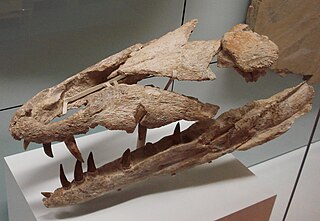
Dakosaurus is an extinct genus within the family Metriorhynchidae that lived during the Late Jurassic and Early Cretaceous. It was large, with teeth that were serrated and compressed lateromedially. The genus was established by Friedrich August von Quenstedt in 1856 for an isolated tooth named Geosaurus maximus by Plieninger. Dakosaurus was a carnivore that spent much, if not all, its life out at sea. The extent of its adaptation to a marine lifestyle means that it is most likely that it mated at sea, but since no eggs or nests have been discovered that have been referred to Dakosaurus, whether it gave birth to live young at sea like dolphins and ichthyosaurs or came ashore like turtles is not known. The name Dakosaurus means "biter lizard", and is derived from the Greek dakos ("biter") and σαῦρος -sauros ("lizard").
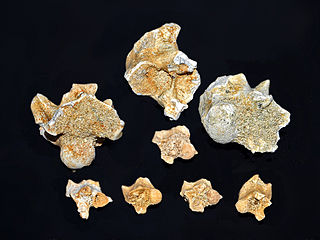
Palaeophis is an extinct genus of marine snake that is the type genus of the extinct snake family Palaeophiidae.
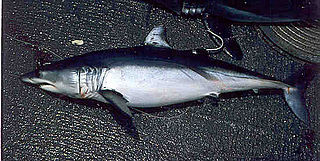
Isurus is a genus of mackerel sharks in the family Lamnidae, commonly known as the mako sharks.
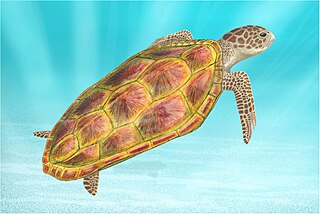
Santanachelys gaffneyi is an extinct species of sea turtle. It is the only species in the genus Santanachelys, which itself is a member of the extinct family Protostegidae. The species was first described from a 20-centimeter long fossil specimen unearthed in 1998 from the Santana Formation of eastern Brazil. From the rock layer from which it was excavated, it was determined that the specimen was from the Early Cretaceous period. It is therefore one of the oldest known sea turtles. It was even recorded as the oldest sea turltle in Encyclopædia Britannica, but a new fossil named Desmatochelyspadillai in 2015 is estimated to be as old as 120 million years.

Cerastoderma is a genus of marine bivalves in the family Cardiidae. It includes the common cockle Cerastoderma edule.

Zaniolepis is a genus of scorpaeniform fish native to the eastern Pacific Ocean. Z. frenata is known to have been a source of food to the Native American inhabitants of San Nicolas Island off the coast of southern California, United States during the Middle Holocene.
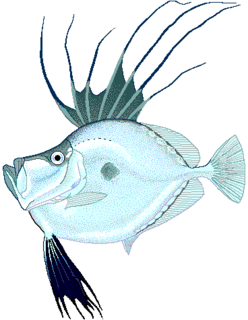
Zenopsis is a genus of dories, a group of marine fish. There are four extant species, but the genus is also known from fossils dating back to the Oligocene epoch. They largely resemble the better-known John dory, and are typically found in relatively deep water, below normal scuba diving depth.

Adelophthalmus is a genus of eurypterid, an extinct group of aquatic arthropods. Fossils of Adelophthalmus have been discovered in deposits ranging in age from the Early Devonian to the Early Permian, which makes it the longest lived of all known eurypterid genera, with a total temporal range of over 120 million years. Adelopthtalmus was the final genus of the Eurypterina suborder of eurypterids and consisted the only known genus of swimming eurypterids from the Middle Devonian until its extinction during the Permian, after which the few surviving eurypterids were all walking forms of the suborder Stylonurina.

Albalophosaurus is a genus of ceratopsian ornithischian dinosaur. It was described in 2009 from remains found in 1997 by Yoshinori Kobayashi from the Kuwajima Formation of central Japan, outcropping in Hakusan in the Ishikawa Prefecture. The holotype, SBEI 176, consists of cranial bones from an incomplete, disarticulated skull and left lower jaw thought to belong to a single individual. The type species is named A. yamaguchiorum. The generic name is derived from Latin albus, "white", and Greek λόϕος (lophos), "crest", a reference to the snow-covered crest of Mount Hakusan. The specific name honours Ichio Yamaguchi and Mikiko Yamaguchi, who discovered and prepared many fossils from the site.
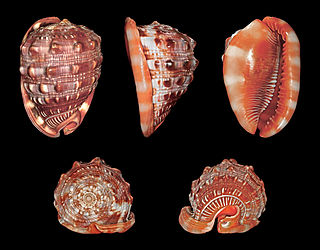
Cypraecassis is a genus of medium-sized to large sea snails, marine gastropod mollusks in the family Cassidae.

Sveltia is a genus of nutmeg sea snails with an extensive fossil range.
Meherrinia is an extinct genus of inioid river dolphin from the Meherrin River, North Carolina, in the United States. First described in 2012, the dolphin is, in most respects, intermediate in form between the living Amazon river dolphin and the La Plata dolphin, although it is probably more closely related to the former. However, the fossil was discovered in what are believed to be marine deposits, dating from the late Miocene, whereas the Amazon river dolphin is an exclusively freshwater species. Meherrinia therefore may be, as of 2012, the only known marine genus of the family Iniidae. Only one species is known.
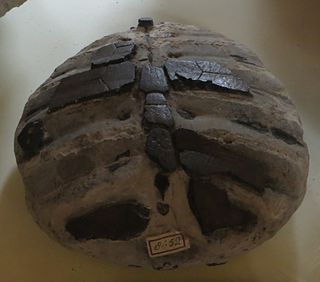
Puppigerus is an extinct genus of sea turtle from the Eocene. It is known from finds in the United States, the United Kingdom, Belgium, Denmark, and Uzbekistan.

Balaenula is an extinct genus of cetacean.
Fish egg fossils are the fossilized remains of fish eggs. Fossil fish eggs have an extensive record going at least as far back as the Devonian and spanning into the Cenozoic era. The eggs of many different fish taxa have contributed to this record, including lobe-finned fish, placoderms, and sharks. Occasionally eggs are preserved still within the mother's body, or associated with fossil embryos. Some fossil eggs possibly laid by fish cannot be confidently distinguished from those laid by amphibians; for example, the ichnogenus Mazonova is known from impressions of eggs which resemble eggs of both fish and amphibians. Paleontologist B.K. Hall has observed that the discovery of fossil fish eggs, embryos and larvae link the sciences of paleontology with evo-devo.

Pterorigonia is an extinct genus of saltwater clams, marine bivalve molluscs in the family Megatrigoniidae. This genus is known in the fossil record from the Jurassic period Tithonian age to the Cretaceous period Maastrichtian age. Species in this genus were facultatively mobile infaunal suspension feeders. The type species of the genus is Pterotrigonia cristata.
Stenorhynchosaurus is an extinct genus of pliosaurid plesiosaurs which lived in South America during the Early Cretaceous. The type species and only known is Stenorhynchosaurus munozi.

Leyvachelys is an extinct genus of turtles in the family Sandownidae from the Early Cretaceous of the present-day Altiplano Cundiboyacense, Eastern Ranges, Colombian Andes. The genus is known only from its type species, Leyvachelys cipadi, described in 2015 by Colombian paleontologist Edwin Cadena. Fossils of Leyvachelys have been found in the fossiliferous Paja Formation, close to Villa de Leyva, Boyacá, after which the genus is named. The holotype specimen is the oldest and most complete sandownid turtle found to date.

















